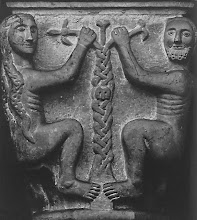There is a hum just beyond our hearing.
A turbine beyond knowing at the hub of being.
Once, walking down the hill road toward the shady gully on a hot still day, we moved step by step into some gradually perceptible hum - I felt it first like fear, my own blood thrumming in my veins, like a warning before waking. And then I saw a shifting cloud, darkling against the trees - frightening and somehow holy. I had no words to name it, but held the hands of my two small daughters more tightly.
How long a moment was that? It seems to still be humming while we stand, still and waiting, the shifting flickering light like a school of fish, like mica flashing as it's wiggled back and forth in the sun, and the hum and buzz mesmerizing us still.
It was a swarm of bees, resting on the air, and moving as with meaning.
Now I understood that Yoruba chant:
Invocation of the Creator
by the Yoruba people (translated by Ulli Beier)
He is patient, he is not angry.
He sits in silence to pass judgment.
He sees you even when he is not looking.
He stays in a far place—but his eyes are on the town.
He stands by his children and lets them succeed.
He causes them to laugh—and they laugh.
Ohoho—the father of laughter.
His eye is full of joy.
He rests in the sky like a swarm of bees.
Obatala—who turns blood into children.
Now I hear that sound of power even in the daily bees who visit the yard, singly and innocent, bent on gathering, to bring back food for the future.
I am following the news of endangered bees and disappearing hives with care because there are fruits beyond knowing and honey beyond sweet that we are losing if we lose the bees.
Mary Oliver's poem, "May," hums with m's and n's - a hum deepening with the voiced echoes of the repeated b's and d's. Her poem buzzes with s's and z's - and even fs and vs and hard ths pick up the buzz like sympathetic wires. She begins like the Yoruba in a chant, composed of short syllables within a strong forward-driving line of four beats, then tumbles (with "dive") down into the throat of flowers at the fourth line, where the rhythm loses itself in delight there in the nectar and pollen, before regathering and backing out onto the lip of the flower, that liminality at the threshold to flight - where lines 5 and 6 swell out to five, six beats each - before pumping back into that heartbeat four-count chant (with one mid-air pause - or one still moment riding at the hub of a spinning top - for emphasis - in the three beats of line 8).
May
by Mary Oliver
May, and among the miles of leafing,
blossoms storm out of the darkness—
windflowers and moccasin flowers. The bees
dive into them and I too, to gather
their spiritual honey. Mute and meek, yet theirs
is the deepest certainty that this existence too—
this sense of well-being, the flourishing
of the physical body—rides
near the hub of the miracle that everything
is a part of, is as good
as a poem or a prayer, can also make
luminous any dark place on earth.



